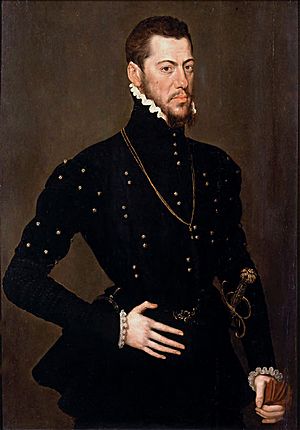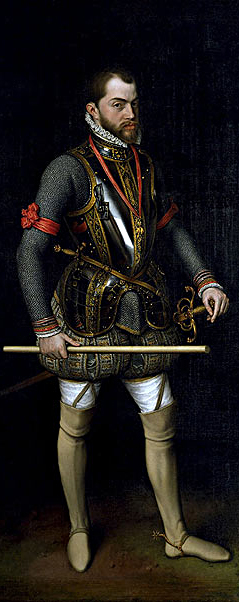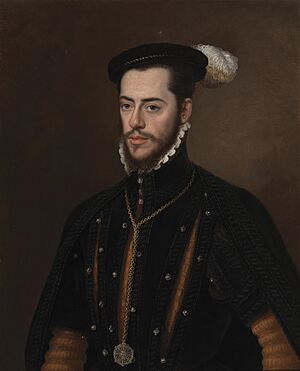Martín de Gurrea y Aragón facts for kids

Martín de Gurrea y Aragón (born May 17, 1525 – died April 25, 1581) was an important Spanish nobleman. He came from a royal family, connected to John II of Aragon. Martín was born and died in Pedrola, a town in Spain. He was also known for collecting art and supporting artists, like Pablo Esquert.
He became the Count of Ribagorza after his father passed away in 1550. Later, in 1558, he also became the 4th Duke of Villahermosa. This happened because the previous Duke lost his title for supporting the King of France against the King of Spain.
Contents
Family Background
The title of Duke of Villahermosa was created by John II of Aragon. He gave it to his son, Alonso, to honor his military achievements. Alonso also became the Count of Ribagorza. Alonso had a son named John (1457-1528). King John II recognized John as his grandson. This was to reward John's mother, María Junquers, who had bravely protected Ribagorza.
John was the Count of Ribagorza and served as a viceroy (a ruler representing the king) in Aragon and Naples. However, he did not inherit the Villahermosa duchy. That title went to Alonso de Aragón, another son. John married a wealthy woman named María López de Gurrea. Through her, he gained control of Luna and Pedrola. After this marriage, John's family started using the name Gurrea before Aragon.
John and María had a son, Alonso Felipe de Gurrea y Aragón (1487-1550). He became the 3rd Count of Ribagorza. Alonso Felipe married Isabel de Cardona y Enríquez de Quiñones from a powerful family. After she died, he married Ana de Sarmiento de Ulloa y Castilla. She was also very wealthy and held rights to salt businesses. Martín de Gurrea y Aragón was their son.
Martín's Life

Martín spent his early years in Pedrola. Later, he was sent to Santiago de Compostela for his education. His mother's brother, Cardinal Pedro Gómez Sarmiento, taught him many languages, including Italian, Latin, ancient Greek, and Hebrew.
After his studies, Martín went to the royal court. He served Empress Isabel of Portugal as a minstrel. Then, he became a page for the future King Philip II of Spain. He also became good friends with Cardinal Granvelle. Martín and Philip II became close. Martín even traveled with Philip to England for his marriage to Mary I. He also went to Brussels in 1555 to see Charles V give up his rule over the Low Countries. Martín divided his time between the royal court and his lands in Pedrola.
In 1557, Martín showed great bravery in the Battle of St Quentin. This earned him the king's favor. His own wealth helped him pay for some important political and diplomatic jobs. However, he had to leave the court to manage his lands in Aragon after his first wife died in 1560.
Martín married Luisa de Borja y Aragón around 1542. She came from the family of the Dukes of Gandía. Luisa and Martín had eight children: Juan, Fernando, Ana, Martín, Francisco, María, Inés, and Juana (who died young). All their children received a good education. Martín and Francisco even attended the University of Salamanca, which was unusual for noblemen at that time.
After Luisa's death, the Duke married a third time in 1566 to María Pérez de Pomar. They had one child, Juliana. Martín also had two daughters outside of marriage, María and Gabriela.
Challenges with Ribagorza
Martín faced a difficult situation with the County of Ribagorza. In 1554, a court took away some of his rights and castles in the County, putting them under direct royal control. Martín fought this decision. In 1565, he passed the County of Ribagorza to his eldest son, Juan de Gurrea y Aragón. Juan was also set to marry Luisa Pacheco Cabrera. However, the wedding was delayed until 1569 because of the legal battle to regain control of the County. Martín eventually won the case in 1567.
Even though he won, the crown had allowed the County to be poorly managed. The damage was lasting. Many years after Martín's death, his family line as Counts of Ribagorza ended. The territory then returned to direct royal rule.
In 1571, his eldest son, Juan, faced serious accusations. He fled to Italy but was captured and executed in 1573. This meant Martín had to take back responsibility for the County of Ribagorza. His hopes for a career at court became less important.
Martín's last years were sad, marked by the loss of several loved ones. These included King Philip II's sister, Joanna of Austria, Princess of Portugal, who Martín had known since childhood. He also lost Diego de Arnedo (a bishop), John of Austria, and his own mother. In 1579, his friend, the royal secretary Antonio Pérez, was arrested. With these difficulties, Martín became more focused on his religious faith. He passed away in 1581. His son Fernando inherited the Duchy of Villahermosa, the County of Ribagorza, and his other titles. Fernando had married Juana de Pernstein y Manrique de Lara.
Art and Culture
Thanks to his education, position, and travels, Martín was part of the important artistic and intellectual groups of his time. His teacher, Cardinal Sarmiento, taught him to love ancient history and art. He became a close friend of Cardinal Granvelle, whom he met early in his life. Granvelle introduced him to artists in Flanders, where Martín met painters like Roland de Mois. Roland de Mois later worked for the Duke.
Martín also shared a passion for collecting coins with Antonio Agustín. He joined the group of a major art supporter in Aragon, don Hernando de Aragón. Hernando was the archbishop of Zaragoza and also a grandson of Ferdinand the Catholic. Martín was also friends with religious scholars like Diego de Arnedo and Pedro Cerbuna.
Martín built a large art collection. It included portraits of the Villahermosa family by Roland de Mois. There was also a portrait of Martín himself by the royal artist Antonio Moro. His collection also featured works by famous artists like Michelangelo, Hieronymus Bosch, and Peter Brueghel the Elder. He left his collection to Pedrola and to the Monastery of Veruela, which he cared for deeply. His collection of coins and medals was one of the first of its kind in Spain. He even wrote a book about them called Discursos sobre medallas y antigüedades.
Family and Children
In 1542, Martín married Luisa de Borja y Aragón. They had eight children:
- Juan de Gurrea y Aragón, who became the 5th Count of Ribagorza.
- Fernando de Gurrea y Aragón, who became the 5th Duke of Villahermosa.
- Francisco de Gurrea y Aragón, who became the 6th Duke of Villahermosa.
- Martín de Gurrea y Aragón, who was the baron of Entenza and Capella.
- Ana de Gurrea y Aragón, who married Felipe Galcerán de Castro de So y Pinós.
- María de Gurrea y Aragón, who became a nun.
- Inés de Gurrea y Aragón, who also became a nun.
- Juana de Gurrea y Aragón, who died when she was a baby.
After Luisa died in 1560, Martín married María Pérez de Pomar. They had one child, Juliana. Juliana married Juan de Aragón, who was the lord of Ballobar and Las Casetas. Martín de Gurrea also had two daughters outside of marriage, named María and Gabriela.
See also
 In Spanish: Martín de Gurrea y Aragón para niños
In Spanish: Martín de Gurrea y Aragón para niños



